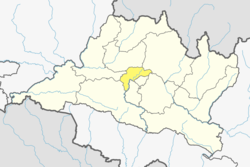Danchhi डाँछी | |
|---|---|
Village of Kageshwari-Manohara Municipality | |
| Nicknames: Thali, Danchhi | |
| Coordinates: 27°44′N85°25′E / 27.73°N 85.41°E | |
| Country | |
| Province | No. 3 |
| District | Kathmandu |
| Government | |
| • Type | Municipality |
| • Member of Parliament | Madhav Kumar Nepal |
| • Mayor | Krishna Hari Thapa |
| Population (2011) | |
• Total | 11,246 |
| Time zone | UTC+5:45 (Nepal Time) |
| Postal code | 44600 |
| Area code | 01 |
| Website | https://www.kageshworimanoharamun.gov.np/en |
Danchhi is a part of Kageshwari-Manohara Municipality in Kathmandu District in Province No. 3 of central Nepal. At the time of the 2011 Nepal census, it had a population of 11,246 and had 2,593 households in it. [1] Danchhi is now included in Kageswori Manohara Municipality. Danchhi/Thali is bounded by Bagmati and Manohara river. The major places include Thali/थली, Nayapati, Bhadrawas, Hariyalinagar, Dumakhal, and Gajarkot. The major government schools are Shree Sahid Aadarsha Uchha MaVi, Shree Kanti Bhairab MaVi, and Shree Chaulanarayan PraVi. Private schools include Miniland English High School, Mount Everest Secondary School, Pragya Sadan School, Alpine Academy, and Hindu Vidhya Peeth.[ citation needed ]
Contents
- Toponymy
- Language origin
- Etymology
- Industries and Economy
- Hindu temples
- Tourist attractions
- References
- External links
Kathmandu valley outer ringroad will pass through this place.


